Occupational health and safety has been at the forefront of employers’ minds for decades, with some safety organizations getting their start in the early 1900s and, of course, OSHA being formed in 1971. However, mental health is often not considered on the same level as occupational health.
In fact, while mental health concerns have recently become more acknowledged by employers, the stigmatization of mental illnesses – from anxiety and depression to more severe conditions – remains in most workplaces.
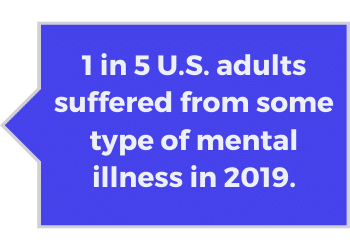
According to the National Institute of Mental Health, nearly one in five U.S. adults suffered from some type of mental illness in 2019, and the numbers have not improved since the COVID-19 pandemic hit the United States in January 2020 and thrust millions of Americans into isolation, unemployment and illness.
Keep reading to learn more about why mental health is important for today’s workers and find some tips on providing mental health support, both in and out of the workplace, which is essential for creating a welcoming, healthy work culture that employees want to keep coming back to.
Looking for more online safety training courses?
Mental Health: The Numbers
In recent years, numerous studies have been conducted on mental health in adults, with most seeming to focus on the millennial generation (25-40 years old in 2021) and the adult segment of the Gen Z generation (18-24 years old).
The focus being on these younger age groups makes sense in terms of the workplace because, in 2016, millennials became the largest sector of the U.S. workforce, with Gen Z at that time reaching working age and only growing.
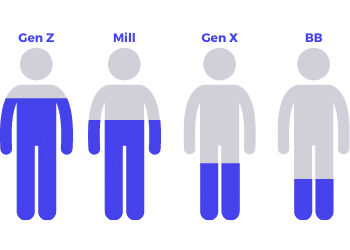
We have already mentioned the data on adults with a mental illness prior to COVID-19, but one study in particular found that every working generation suffered from a mental health issue during the pandemic (71% of Gen Zers, 59% of millennials, 36% of Gen Xers and 22% of baby boomers).
Clearly every generation is affected by mental health issues, but how are employers currently dealing with mental health, as opposed to occupational and physical health? Not very well, it would seem.
Mind Share Partners, a nonprofit aiming to change the culture of workplace mental health, along with SAP and Qualtrics conducted a study on the prevalence of mental health challenges and stigmas in U.S. workplaces.
One of the findings with the most parity, though perhaps one that isn’t all too surprising, is that despite 86% of respondents saying a company’s culture should support mental health, only 41% feel that is actually happening.
Looking for an employer who cares about the mental and emotional well-being of their employees has recently become a higher priority for many job seekers, and this study from Mind Share Partners only further solidifies those feelings.
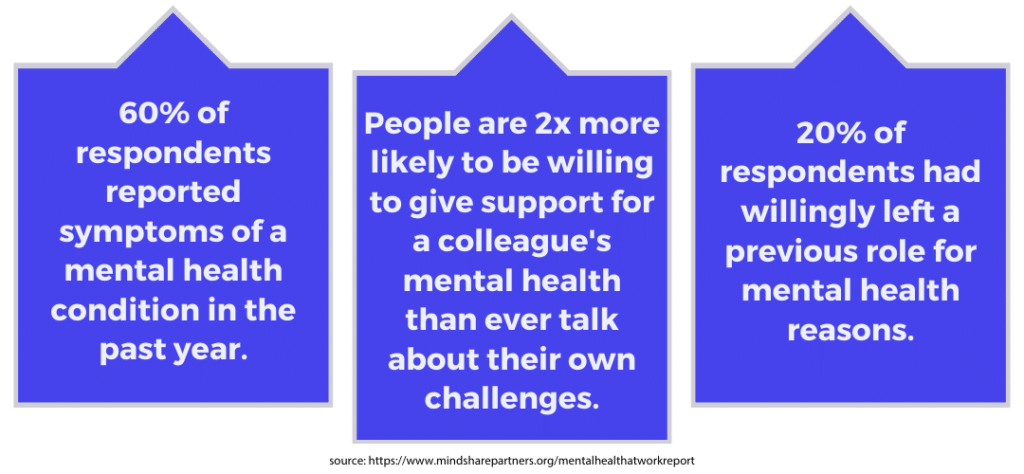
As for how mental health can affect workplace performance, there are both the immediate, obvious results and those that are less clear.
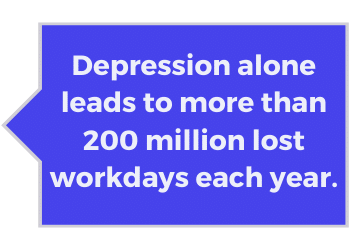
The Centers for Disease Control and Prevention found that depression alone leads to more than 200 million lost workdays each year, as employees with depression miss an average of 4.8 workdays every three months.
In the same study from Mind Share Partners, 61% of respondents felt that their mental health impacts their productivity. While this of course doesn’t necessarily mean lost workdays, unproductive and underperforming employees can hurt businesses in the long run.
Most recently, roughly 1 in 3 participants in a Deloitte study admitted they have taken time off work due to stress and anxiety. Interestingly, of the remaining respondents who did not take time off, 40% said they were stressed enough to do so but chose to work through it. Many times, this is due to working in an environment where they feel they cannot take time off unless they are physically sick.
How Employers Can Provide Mental Health Relief
Now that you understand a little more about how many employees may be dealing with some type of mental health issue, it is important to know what your options are as far as providing support.
Incorporate mental health in your workplace culture
Workplace culture is simply the various attitudes, beliefs and behaviors that make up the atmosphere of your work environment and that set the context for everything your organization does. While this typically includes things like how communication occurs and drives hiring decisions, employee safety and mental health are two keys that must be included in any complete workplace culture.
When mental health is made a cornerstone of a company’s culture, employees feel more comfortable not only being honest about any struggles they are having, but they are also more likely to seek appropriate help. Leaders play a big part in reducing the stigma around mental health by openly talking about it and knowing what to do next should people say they need support.

Let workers take mental health days
Most Americans are not good at taking days off of work. Even before the pandemic hit in early 2020, employees were only using about half of their paid-time off or vacation days. Perhaps unsurprisingly, PTO being used for a “mental health day” is even more unlikely to happen.
However, if your workplace is open regarding mental health discussions, employees are more likely to feel empowered to admit when they need a break. This is also another area where leadership can play a role, by taking their own mental health days or by actively encouraging the company to do so.
Encourage a healthy work-life balance
A recent study over the largest working generation — millennials — found that 73% reported working more than 40 hours per week, with almost 25% working more than 50 hours per week. This may seem like a dream for an employer, but it can actually be a hindrance in the long run.
There are numerous downfalls to a negative work-life balance, including decreased productivity, higher employee turnover and negative company perception. When you encourage your employees to only work the weekly hours that are necessary (which of course can vary greatly by industry and company), you create a stronger balance and give people time to recharge themselves, both physically and mentally.
When possible, keep work at work

On a related note, many employees may not be clocked in and working more than 40 hours per week, but millions still stay plugged in, making themselves available for after-hours emails, phone calls and sometimes even meetings. Doing this creates added stress on the employee, as they feel they always need to be ready to work, regardless of personal and family needs.
By letting your employees keep work at work, you create a division of priorities. People are more likely to be fully present during their work day because they know they get to go home and not think about work for a few hours. Of course, sometimes after-work emails or calls might be necessary, but making it clear that is the exception and not the rule helps alleviate unneeded stress.
Provide resources for mental health professionals
A study by Mental Health America found that 86 percent of people who did not receive mental health treatment were covered by health insurance, indicating that coverage does not equal access to care. It is crucial that employees know where to go and who to turn to. You likely provide information on accessing medical doctors, dentists or optometrists; why not mental health professionals, too?
The CDC advocates strongly for mental health awareness in the workplace and they provide several suggestions for steps employers can take:
- Make mental health self-assessment tools available to all employees.
- Offer health insurance with no or low out-of-pocket costs for certain medications and mental health counseling.
- Provide free or subsidized lifestyle coaching, counseling or self-management programs.
- Distribute materials about poor mental health and options for treatment.
- Provide managers with training to recognize the signs and symptoms of stress and depression.
Create and maintain quiet spaces
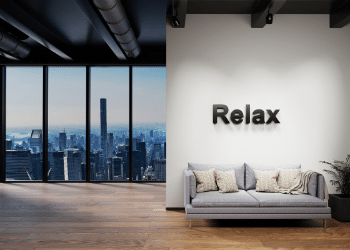
No matter what type of work environment you are in, you can probably understand the desire of many employees to have some “alone time” to take a short break from their email, phones and even co-workers. You may know that having a clean, private place for employees to pump breast milk is required by law (when necessary and applicable), but what about a quiet space for general use?
If you have a spare meeting space, this could be an ideal quiet area, but this does not work for every company. In many cases, simply setting up an area where employees can sit and relax for a few minutes is all you need. If possible, use some comfortable chairs and add a partition or temporary wall. Most importantly, make sure employees do not feel shamed for using these spaces.
Offer relevant training
One very effective step toward helping your employees address, and ideally curtail, any mental health issues is to offer training courses that can assist them throughout their workday — and their lives.
There are many soft skills that make for good training courses, such as time management and conflict resolution, that can help to reduce stress. Also, offering company wide training over topics like bullying in the workplace shows you are creating a zero-tolerance environment, putting your employees’ mental and physical health above anything else.
Understand Your Employees’ Needs
Of course, every organization will have their own mental health-related issues to address, due to different company sizes, industries, jobsite setups and employee demographics. The best thing you can do is talk to your employees. Find out what their concerns are, work together to come up with solutions and be open in continuing discussions.
Remember that mental health awareness should — without question — be part of your workplace culture and can easily be tied into any safety program. See how SafetySkills can help you make sure your health and safety program is in line, not only for occupational safety needs, but for many mental health issues and numerous off-the-job situations as well.


